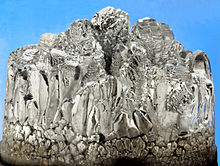 Type: Lesser Element
Type: Lesser Element
Periodic Element: (Mg)
RDA: 300-350 mg – about 1.2g
Importance- To Body:
Important cofactor in a number of metabolic reactions, present in bone. Necessary for proper bone structure, regulation of nerve and muscle action. Catalyst for intracellular enzymatic reactions, in relation to carbohydrate metabolism. Constituent of many coenzymes that play a role in conversion of ATP to ADP. Required for normal muscle and nerve irritability.
Distribution- In Body:
0.1 Approx. % of Body Mass
In all cells, particularly abundant in bones; absorption parallels that of calcium; excreted chiefly in urine.
Excess Effects:
Diarrhea
Deficiency Effects:
Tetany; Neuromuscular Problems, Tremors; seen in alcoholism and severe renal disease
Sources Food:
Dairy products, Milk, Leafy Green Vegetables, Meat, Nuts, Legumes, Whole-Grain Cereals
Sources Environmental/Geographic:
None listed
Supplemental information:
 |
|||||||||||||||||||||
| General properties | |||||||||||||||||||||
|---|---|---|---|---|---|---|---|---|---|---|---|---|---|---|---|---|---|---|---|---|---|
| Pronunciation | /mæɡˈniːziəm/ |
||||||||||||||||||||
| Appearance | shiny grey solid | ||||||||||||||||||||
| Standard atomic weight (Ar, standard) | [24.304, 24.307] conventional: 24.305 | ||||||||||||||||||||
| Magnesium in the periodic table | |||||||||||||||||||||
|
|||||||||||||||||||||
| Atomic number (Z) | 12 | ||||||||||||||||||||
| Group | group 2 (alkaline earth metals) | ||||||||||||||||||||
| Period | period 3 | ||||||||||||||||||||
| Element category | alkaline earth metal | ||||||||||||||||||||
| Block | s-block | ||||||||||||||||||||
| Electron configuration | [Ne] 3s2 | ||||||||||||||||||||
|
Electrons per shell
|
2, 8, 2 | ||||||||||||||||||||
| Physical properties | |||||||||||||||||||||
| Phase at STP | solid | ||||||||||||||||||||
| Melting point | 923 K (650 °C, 1202 °F) | ||||||||||||||||||||
| Boiling point | 1363 K (1091 °C, 1994 °F) | ||||||||||||||||||||
| Density (near r.t.) | 1.738 g/cm3 | ||||||||||||||||||||
| when liquid (at m.p.) | 1.584 g/cm3 | ||||||||||||||||||||
| Heat of fusion | 8.48 kJ/mol | ||||||||||||||||||||
| Heat of vaporization | 128 kJ/mol | ||||||||||||||||||||
| Molar heat capacity | 24.869 J/(mol·K) | ||||||||||||||||||||
Vapor pressure
|
|||||||||||||||||||||
| Atomic properties | |||||||||||||||||||||
| Oxidation states | +2, +1 |
||||||||||||||||||||
| Electronegativity | Pauling scale: 1.31 | ||||||||||||||||||||
| Ionization energies |
|
||||||||||||||||||||
| Atomic radius | empirical: 160 pm | ||||||||||||||||||||
| Covalent radius | 141±7 pm | ||||||||||||||||||||
| Van der Waals radius | 173 pm | ||||||||||||||||||||
|
|||||||||||||||||||||
| Miscellanea | |||||||||||||||||||||
| Crystal structure | hexagonal close-packed (hcp) | ||||||||||||||||||||
| Speed of sound thin rod | 4940 m/s (at r.t.) (annealed) | ||||||||||||||||||||
| Thermal expansion | 24.8 µm/(m·K) (at 25 °C) | ||||||||||||||||||||
| Thermal conductivity | 156 W/(m·K) | ||||||||||||||||||||
| Electrical resistivity | 43.9 nΩ·m (at 20 °C) | ||||||||||||||||||||
| Magnetic ordering | paramagnetic | ||||||||||||||||||||
| Magnetic susceptibility | +13.1·10−6 cm3/mol (298 K) | ||||||||||||||||||||
| Young's modulus | 45 GPa | ||||||||||||||||||||
| Shear modulus | 17 GPa | ||||||||||||||||||||
| Bulk modulus | 35.4 GPa | ||||||||||||||||||||
| Poisson ratio | 0.290 | ||||||||||||||||||||
| Mohs hardness | 1–2.5 | ||||||||||||||||||||
| Brinell hardness | 44–260 MPa | ||||||||||||||||||||
| CAS Number | 7439-95-4 | ||||||||||||||||||||
| History | |||||||||||||||||||||
| Naming | after Magnesia, Greece | ||||||||||||||||||||
| Discovery | Joseph Black (1755) | ||||||||||||||||||||
| First isolation | Humphry Davy (1808) | ||||||||||||||||||||
| Main isotopes of magnesium | |||||||||||||||||||||
|
|||||||||||||||||||||
Magnesium is a chemical element with symbol Mg and atomic number 12. It is a shiny gray solid which bears a close physical resemblance to the other five elements in the second column (group 2, or alkaline earth metals) of the periodic table: all group 2 elements have the same electron configuration in the outer electron shell and a similar crystal structure.
Magnesium is the ninth most abundant element in the universe. It is produced in large, aging stars from the sequential addition of three helium nuclei to a carbon nucleus. When such stars explode as supernovas, much of the magnesium is expelled into the interstellar medium where it may recycle into new star systems. Magnesium is the eighth most abundant element in the Earth's crust and the fourth most common element in the Earth (after iron, oxygen and silicon), making up 13% of the planet's mass and a large fraction of the planet's mantle. It is the third most abundant element dissolved in seawater, after sodium and chlorine.
Magnesium occurs naturally only in combination with other elements, where it invariably has a +2 oxidation state. The free element (metal) can be produced artificially, and is highly reactive (though in the atmosphere, it is soon coated in a thin layer of oxide that partly inhibits reactivity — see passivation). The free metal burns with a characteristic brilliant-white light. The metal is now obtained mainly by electrolysis of magnesium salts obtained from brine, and is used primarily as a component in aluminium-magnesium alloys, sometimes called magnalium or magnelium. Magnesium is less dense than aluminium, and the alloy is prized for its combination of lightness and strength.
Magnesium is the eleventh most abundant element by mass in the human body and is essential to all cells and some 300 enzymes. Magnesium ions interact with polyphosphate compounds such as ATP, DNA, and RNA. Hundreds of enzymes require magnesium ions to function. Magnesium compounds are used medicinally as common laxatives, antacids (e.g., milk of magnesia), and to stabilize abnormal nerve excitation or blood vessel spasm in such conditions as eclampsia.


